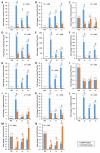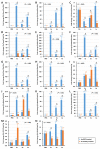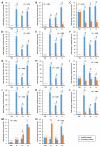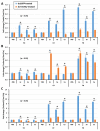IKKγ/NEMO Is Required to Confer Antimicrobial Innate Immune Responses in the Yellow Mealworm, Tenebrio Molitor
- PMID: 32937897
- PMCID: PMC7555931
- DOI: 10.3390/ijms21186734
IKKγ/NEMO Is Required to Confer Antimicrobial Innate Immune Responses in the Yellow Mealworm, Tenebrio Molitor
Abstract
IKKγ/NEMO is the regulatory subunit of the IκB kinase (IKK) complex, which regulates the NF-κB signaling pathway. Within the IKK complex, IKKγ/NEMO is the non-catalytic subunit, whereas IKKα and IKKβ are the structurally related catalytic subunits. In this study, TmIKKγ was screened from the Tenebrio molitor RNA-Seq database and functionally characterized using RNAi screening for its role in regulating T. molitor antimicrobial peptide (AMP) genes after microbial challenges. The TmIKKγ transcript is 1521 bp that putatively encodes a polypeptide of 506 amino acid residues. TmIKKγ contains a NF-κB essential modulator (NEMO) and a leucine zipper domain of coiled coil region 2 (LZCC2). A phylogenetic analysis confirmed its homology to the red flour beetle, Tribolium castaneum IKKγ (TcIKKγ). The expression of TmIKKγ mRNA showed that it might function in diverse tissues of the insect, with a higher expression in the hemocytes and the fat body of the late-instar larvae. TmIKKγ mRNA expression was induced by Escherichia coli, Staphylococcus aureus, and Candida albicans challenges in the whole larvae and in tissues such as the hemocytes, gut and fat body. The knockdown of TmIKKγ mRNA significantly reduced the survival of the larvae after microbial challenges. Furthermore, we investigated the tissue-specific induction patterns of fourteen T. molitor AMP genes in TmIKKγ mRNA-silenced individuals after microbial challenges. In general, the mRNA expression of TmTenecin1, -2, and -4; TmDefensin1 and -2; TmColeoptericin1 and 2; and TmAttacin1a, 1b, and 2 were found to be downregulated in the hemocytes, gut, and fat body tissues in the TmIKKγ-silenced individuals after microbial challenges. Under similar conditions, TmRelish (NF-κB transcription factor) mRNA was also found to be downregulated. Thus, TmIKKγ is an important factor in the antimicrobial innate immune response of T. molitor.
Keywords: NF-κB transcription factor; RNAi; Tenebrio molitor; antimicrobial peptides; insect immunity.
Conflict of interest statement
The authors declare no conflict of interest.
Figures









Similar articles
-
TmSpz-like Plays a Fundamental Role in Response to E. coli but Not S. aureus or C. albican Infection in Tenebrio molitor via Regulation of Antimicrobial Peptide Production.Int J Mol Sci. 2021 Oct 8;22(19):10888. doi: 10.3390/ijms221910888. Int J Mol Sci. 2021. PMID: 34639230 Free PMC article.
-
IKKβ regulates antimicrobial innate immune responses in the yellow mealworm, Tenebrio molitor.Dev Comp Immunol. 2023 Oct;147:104761. doi: 10.1016/j.dci.2023.104761. Epub 2023 Jun 16. Dev Comp Immunol. 2023. PMID: 37331676
-
TmDorX2 positively regulates antimicrobial peptides in Tenebrio molitor gut, fat body, and hemocytes in response to bacterial and fungal infection.Sci Rep. 2019 Nov 14;9(1):16878. doi: 10.1038/s41598-019-53497-4. Sci Rep. 2019. PMID: 31728023 Free PMC article.
-
Autophagy in Tenebrio molitor Immunity: Conserved Antimicrobial Functions in Insect Defenses.Front Immunol. 2021 May 31;12:667664. doi: 10.3389/fimmu.2021.667664. eCollection 2021. Front Immunol. 2021. PMID: 34135896 Free PMC article. Review.
-
Regulation and function of IKK and IKK-related kinases.Sci STKE. 2006 Oct 17;2006(357):re13. doi: 10.1126/stke.3572006re13. Sci STKE. 2006. PMID: 17047224 Review.
Cited by
-
Effects of TmTak1 silencing on AMP production as an Imd pathway component in Tenebrio molitor.Sci Rep. 2023 Nov 2;13(1):18914. doi: 10.1038/s41598-023-45978-4. Sci Rep. 2023. PMID: 37919359 Free PMC article.
-
Recent trends in insect gut immunity.Front Immunol. 2023 Dec 18;14:1272143. doi: 10.3389/fimmu.2023.1272143. eCollection 2023. Front Immunol. 2023. PMID: 38193088 Free PMC article. Review.
-
TmSpz-like Plays a Fundamental Role in Response to E. coli but Not S. aureus or C. albican Infection in Tenebrio molitor via Regulation of Antimicrobial Peptide Production.Int J Mol Sci. 2021 Oct 8;22(19):10888. doi: 10.3390/ijms221910888. Int J Mol Sci. 2021. PMID: 34639230 Free PMC article.
-
Current Status of Immune Deficiency Pathway in Tenebrio molitor Innate Immunity.Front Immunol. 2022 Jul 4;13:906192. doi: 10.3389/fimmu.2022.906192. eCollection 2022. Front Immunol. 2022. PMID: 35860244 Free PMC article. Review.
-
Transcriptome sequencing of the endangered land snail Karaftohelix adamsi from the Island Ulleung: De novo assembly, annotation, valuation of fitness genes and SSR markers.Genes Genomics. 2024 Jul;46(7):851-870. doi: 10.1007/s13258-024-01511-z. Epub 2024 May 29. Genes Genomics. 2024. PMID: 38809491
References
MeSH terms
Substances
Grants and funding
LinkOut - more resources
Full Text Sources
Miscellaneous

